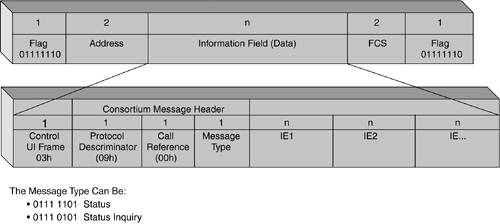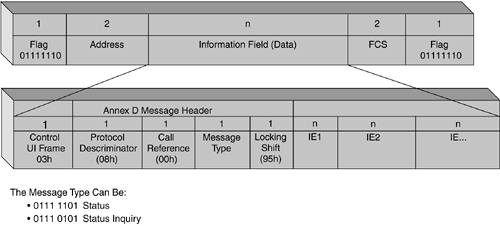LMI
| A consortium of companies known as the Gang of Four, which is composed of Cisco Systems, Inc., Digital Equipment Corp, Northern Telecom, and StrataCom, Inc., developed and published the LMI for UNI. The LMI is a set of enhancements to the basic Frame Relay specification that include the following:
The derivatives of the LMI Consortium were formally adopted as T1.617 Annex D and Q.933 Annex A. The first group of messages, known as the virtual circuit status messages, are the only common LMI (adopted by all vendors) extensions (see Figure 15-8). Figure 15-8. The UNI LMI Area of Operation
Three different LMI types are supported by Cisco:
These formats are related to Frame Relay troubleshooting, and their differences are described in the following sections. The purpose of the Annex D LMI type is to create a multivendor LMI type. The difference between Cisco LMI and Annex D LMI is that, in Annex D, ANSI provides a signaling scheme derived from the initial LMI agreement. To avoid confusion, the Consortium LMI is referred to as the Consortium, and the ANSI T1.617 LMI is referred to as Annex D.[3] The LMI messages periodically poll the network using the Q.931 structure, and are transmitted in HDLC UI frames. To indicate the LMI message, Consortium LMI uses DLCI 1023, whereas Annex D LMI uses DLCI 0. In both cases, the FECN, BECN, and DE bits are set to 0. Within the Q.931 header of Annex D messages, the PD field is set to 08h, and the Consortium LMI sets the PD field to 09h. The Dummy Call Reference and message types are identical, but unlike Consortium, Annex D adds the Locking Shift information element (IE) to the message header. NOTE The remaining discussion uses Consortium to refer to the original LMI specifications, and Annex D to refer to ANSI (T1.617 Annex D). Consortium (Cisco) LMI TypeThe Consortium designed the LMI protocol to perform the following functions:
The Consortium LMI defines two messages: status enquiry and status. The general format of this LMI type is shown in Figure 15-9. Figure 15-9. Format of Consortium LMI Messages
Both messages are sent in HDLC UI frames, with a Control field value of 03h. The three-octet message header is based on Q.931 and includes a Protocol Discriminator (09h), a Call Reference Value (00h, also a Dummy Call Reference), and a Message Type indicator. The message types are 75h (0111 0101) to indicate status enquiry, and 7Dh (0111 1101) to indicate status. Annex D (ANSI) LMI TypeThe T1.617 Annex D defines a polling protocol for use between the router and the network to exchange information about the status of the interfaces and the defined PVCs. The functions of the protocol are as follows:
The router periodically polls the network, sending a status enquiry message, and the network responds with a status message. The polling period is a negotiable parameter, and ten seconds is the default. The first poll requests a link integrity verification response to determine the status of the in-channel signaling link. Another polling cycle (typically every six polling cycles) occurs when the user requests the status of all PVCs on the interface. The resulting response is a full status message that contains information on each PVC that is configured on that physical channel. The information includes the recent history of the PVC and its availability (inactive or active). The periodic polling for Annex D also detects error conditions, such as reliability errors of DLCI 0, signaling-link protocol errors, or internal network problems. The format of these messages is shown in Figure 15-10. Figure 15-10. Format of Annex D LMI Messages
Although the Consortium status enquiry messages use the Report Type and Keepalive Sequence IEs, the Annex D status enquiry messages contain Report Type and Link Integrity Verification IEs (see Figure 17-3 and 17-5). The Link Integrity Verification IE (03h) provides an identification ID in the first byte. The second byte indicates the length of the integrity verification content. The third byte is the end sequence number and the fourth byte is the receive sequence number. ITU-T Q.933 Annex A LMI TypeThe vast majority of contemporary Frame Relay solutions are based on PVCs. However, for SVC, the ITU-T Q.933 Annex A LMI type is recommended. For more information, refer to Cisco documentation or the book Frame Relay for High-Speed Networks, by Walter Goralski. In terms of LMI global addressing, Frame Relay resembles a LAN. Address Resolution Protocol (ARP) operates in Frame Relay exactly as it does in a LAN where ARP maps Layer 3 IP to Layer 2 Media Access Control (MAC). The Inverse ARP implementation for Frame Relay is described in the next section. |
EAN: 2147483647
Pages: 235


